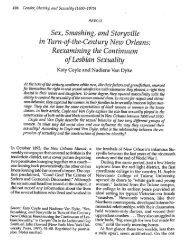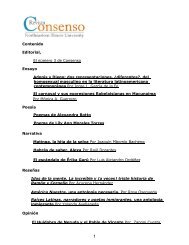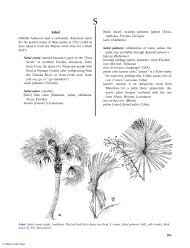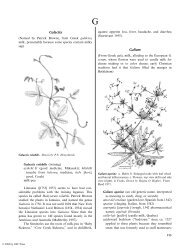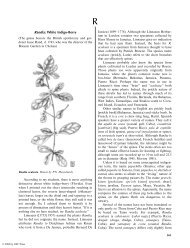Herba Cana - Northeastern Illinois University
Herba Cana - Northeastern Illinois University
Herba Cana - Northeastern Illinois University
Create successful ePaper yourself
Turn your PDF publications into a flip-book with our unique Google optimized e-Paper software.
© 2004 by CRC Press<br />
528 Florida Ethnobotany<br />
(1753) formalized the use of Plumbago to the plant<br />
and it has remained that way.<br />
The white plumbago (Bahamas, Puerto Rico) in<br />
southern Florida is P. scandens. That sprawling herb is<br />
also found in the Bahamas, the West Indies, Mexico<br />
(Sonora and Tamaulipas south) to Costa Rica and<br />
South America to Peru, Bolivia, and Argentina. The<br />
plant has multiple names throughout its range because<br />
it is notorious for several reasons..<br />
The names for the American plants were complicated<br />
because Europeans already knew P. europaea.<br />
They called the Old World plants by two sets of<br />
names*/one mentioning the metal lead, and the other<br />
teeth.<br />
Mostly, P. europaea is associated with the metal in<br />
the names leadwort (English), piombaggine (lead<br />
plant, Italian), plúmbago (Sonora, Spanish), and<br />
Bleiwurz (lead herb, German). Those names are either<br />
based on an old belief that it could be used to cure<br />
lead poisoning (Bremness 1994), because of the ‘‘leadcolored’’<br />
flowers (OED 1971), or because the roots<br />
impart a lead color to the hands when handled<br />
(Walker 1976). Few English speakers recognize the<br />
word plumbago, and they use its translated form,<br />
leadwort. According to Nathan Bailey’s A Universal<br />
Etymological English Dictionary, ‘‘leadwort’’ was first<br />
used in English in 1727.<br />
The other names for P. europaea are based on its<br />
use in treating toothache. Surely the oldest name of<br />
those referring to teeth was Lepidium Dentillaria<br />
dictum (little scale called dentillaria) published by<br />
Gaspard Bauhin in 1623. That name evolved into<br />
dentelaire (French) and dentilária (Portuguese). This<br />
knowledge of use was carried to the Americas where P.<br />
scandens became dentelaire [dentelle] (Haiti) and<br />
dentelária (Oaxaca, Cuba).<br />
The European Spanish hierba blesa (pretty herb)<br />
and velesa (pretty one) are related, and these were<br />
applied to P. scandens as belesa [beleza] (Puerto Rico).<br />
These probably gave rise to bella Emilia (pretty Emily,<br />
Dominican Republic, Colombia, Argentina), belleza<br />
enredadera [veleza enredadera] (pretty twiner, Puerto<br />
Rico), and embeles [embeleso] (Yucatán, Cuba). There<br />
is either a linguistic relationship between these and<br />
Spanish embelezar (to enchant) because of the beauty<br />
of the flower or simply as a result of confusion with<br />
that word.<br />
Throughout the Americas, there is an ambiguity of<br />
feelings toward these plants that is typified by homme<br />
[à] deux faces (man with two faces, Haiti). The herbs<br />
are pretty because of their flowers, but like their<br />
European cousin, they are ‘‘acrid, blistering, and<br />
emetic’’ (Polunin 1969). Many of the common names<br />
warn against those traits.<br />
Some of the names are direct, as in blister leaf<br />
(Virgin Islands), chilillo (little pepper, Veracruz), herbe<br />
brûlante (burning herb, Guadeloupe, Martinique),<br />
queimadeira (burner, Brazil), sarne vejiguilla (blister<br />
herb, Peru), yerba de vejigatorio (irritant herb,<br />
Guyana), tlalchinchinolli (from tlachichinacapololli,<br />
cruelly tortured, Náhuatl, Querétaro), and tlepatli<br />
(fire medicine, Náhuatl, Querétaro). Others damn<br />
them by inference or association, as in caataia (caa,<br />
plant, taia,fromta’yá /Zanthoxylum violaceum in the<br />
Rutaceae, a family famous for volatile oils, Tupí,<br />
Brazil), folhas de louco [louco] (crazy leaf, Brazil),<br />
malacara (bad-face, Cuba), and herbe bourrique (sheass<br />
herb, Haiti). Surely, the fiery juice led to the<br />
comparison with mustards and the names moutard<br />
pays (wild mustard, Guadeloupe, Martinique) and<br />
sinapisme (from Latin sinapis, mustard, Guadeloupe,<br />
Martinique).<br />
Some people consider the plants the devil incarnate,<br />
with erva do diabo [erva de diabo] (devil’s herb,<br />
Brazil), herbe au diable (devil’s herb, Haiti), hierba del<br />
diablo [yerba del diablo] (devil’s herb, Dominican<br />
Republic, Colombia, Argentina), and mauvaise herbe<br />
(damned herb, Haiti). At the opposite extreme, some<br />
people consider them an erva divina (divine herb,<br />
Brazil).<br />
Other names are more obtuse allusions to medicines.<br />
These include doctor-bush [doctorbush] (Bahamas,<br />
Florida), herbe à Madame Bihoret [zèbe Man<br />
Bihoret] (Guadeloupe, Martinique), folha de louro<br />
(parrot leaf, Brazil), hierba del negro (negro’s herb,<br />
Oaxaca), hierba del pajaro (bird’s herb, Panama),<br />
hierba de alacrán (scorpion herb, Sinaloa, Jalisco,<br />
San Luis Potosí, Oaxaca, Guanajuato), lagaña de aura<br />
(vulture’s eyelid, Cuba), lagaña de perro (dog’s eyelid,<br />
Morelos, Cuba), and muela de alacrán (scorpion’s<br />
molar, Mexico).<br />
People also find the sticky fruits worthy of<br />
comment. Some of these names are positive, such as<br />
collant (sticky one, Guadeloupe, Martinique), erva de<br />
amor (love herb, Brazil), and meladillo [melallillo,<br />
mielilla] [silvestre] ([wild] honey-giver, Puerto Rico,<br />
Cuba, Mexico). Typically, meladillo is applied to P.<br />
auriculata in Puerto Rico. Other names are negative,<br />
as in pegajoso (sticky one, Tamaulipas, Sinaloa), pegapollo<br />
(chicken-catcher, Dominican Republic), pegoso<br />
(sticky), mata-pollo (chicken-killer, Dominican Republic),<br />
and visqueira (the viscous one, Brazil).<br />
Some people do not know of the medicinal uses.<br />
They may be the ones calling the plants canutillo (little<br />
tube, maybe the flower, Sinaloa), guapote [guapito]<br />
(from guapo, handsome, Venezuela, Peru), estrenina<br />
(little gift, Sonora), Isabel (Hispaniola), jazmín azul<br />
(blue jassmine, Yucatán), and jazmim azul (blue<br />
jassmine, Brazil).





